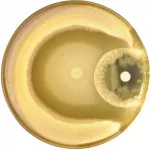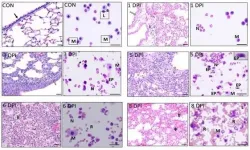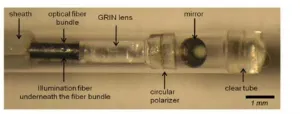FSU researchers enhance quantum machine learning algorithms
2021-03-16
(Press-News.org) A Florida State University professor's research could help quantum computing fulfill its promise as a powerful computational tool.
William Oates, the Cummins Inc. Professor in Mechanical Engineering and chair of the Department of Mechanical Engineering at the FAMU-FSU College of Engineering, and postdoctoral researcher Guanglei Xu found a way to automatically infer parameters used in an important quantum Boltzmann machine algorithm for machine learning applications.
Their findings were published in Scientific Reports.
The work could help build artificial neural networks that could be used for training computers to solve complicated, interconnected problems like image recognition, drug discovery and the creation of new materials.
"There's a belief that quantum computing, as it comes online and grows in computational power, can provide you with some new tools, but figuring out how to program it and how to apply it in certain applications is a big question," Oates said.
Quantum bits, unlike binary bits in a standard computer, can exist in more than one state at a time, a concept known as superposition. Measuring the state of a quantum bit -- or qubit -- causes it to lose that special state, so quantum computers work by calculating the probability of a qubit's state before it is observed.
Specialized quantum computers known as quantum annealers are one tool for doing this type of computing. They work by representing each state of a qubit as an energy level. The lowest energy state among its qubits gives the solution to a problem. The result is a machine that could handle complicated, interconnected systems that would take a regular computer a very long time to calculate -- like building a neural network.
One way to build neural networks is by using a restricted Boltzmann machine, an algorithm that uses probability to learn based on inputs given to the network. Oates and Xu found a way to automatically calculate an important parameter associated with effective temperature that is used in that algorithm. Restricted Boltzmann machines typically guess at that parameter instead, which requires testing to confirm and can change whenever the computer is asked to investigate a new problem.
"That parameter in the model replicates what the quantum annealer is doing," Oates said. "If you can accurately estimate it, you can train your neural network more effectively and use it for predicting things."
INFORMATION:
This research was supported by Cummins Inc. and used resources of the Oak Ridge Leadership Computing Facility, which is a DOE Office of Science User Facility.
[Attachments] See images for this press release:

ELSE PRESS RELEASES FROM THIS DATE:
2021-03-16
Prof. HUANG Weixin and ZHANG Qun from University of Science and Technology of China (USTC) of the Chinese Academy of Sciences (CAS), together with domestic collaborators, probed into the photocatalytic oxidation of methanol on various anatase TiO2 nanocrystals. The results were published on Angewandte Chemie International Edition.
Semiconductor-based photocatalysis has attracted extensive attention since its discovery, owing to its environmentally friendly production of chemical fuel utilizing solar energy.
A photocatalytic reaction consists of light absorption and charge generation within photocatalysts, ...
2021-03-16
Nanozymes, a group of inorganic catalysis-efficient particles, have been proposed as promising antimicrobials against bacteria. They are efficient in killing bacteria, thanks to their production of reactive oxygen species (ROS).
Despite this advantage, nanozymes are generally toxic to both bacteria and mammalian cells, that is, they are also toxic to our own cells. This is mainly because of the intrinsic inability of ROS to distinguish bacteria from mammalian cells.
In a study published in Nature Communications, the research team led by XIONG Yujie and YANG Lihua from University of Science and Technology (USTC) of the Chinese Academy of Sciences (CAS) proposed a novel method to construct efficient-while-little-toxic nanozymes.
The researchers showed that nanozymes ...
2021-03-16
Females who are fit and healthy tend to burn more fat when they exercise than men, according to new research from a team of sports nutritionists.
The research, comprising two new studies from academics led by the University of Bath's Centre for Nutrition, Exercise & Metabolism, analysed the factors that most influenced individuals' capacity to burn body fat when undertaking endurance sports.
How the body burns fat is important to all of us for good metabolic health, insulin sensitivity and in reducing the risk of developing Type II diabetes. But, for endurance sport ...
2021-03-16
Research led by the Cavendish Laboratory at the University of Cambridge has identified a material that could help tackle speed and energy, the two biggest challenges for computers of the future.
Research in the field of light-based computing - using light instead of electricity for computation to go beyond the limits of today's computers - is moving fast, but barriers remain in developing optical switching, the process by which light would be easily turned 'on' and 'off', reflecting or transmitting light on-demand.
The study, published in Nature Communications, shows that a material known as Ta2NiSe5 could switch between a window and a mirror in a quadrillionth of a second when struck by a short laser pulse, paving the way for the development ...
2021-03-16
The bacterial equivalent of a traffic jam causes multilayered biofilms to form in the presence of antibiotics, shows a study published today in eLife.
The study reveals how the collective behaviour of bacterial colonies may contribute to the emergence of antibiotic resistance. These insights could pave the way to new approaches for treating bacterial infections that help thwart the emergence of resistance.
Bacteria can acquire resistance to antibiotics through genetic mutations. But they can also defend themselves via collective behaviours such as joining together ...
2021-03-16
The inclusion of a special new perovskite layer has enabled scientists to create a "spin-polarized LED" without needing a magnetic field or extremely low temperatures, potentially clearing the path to a raft of novel technologies.
Details of the research conducted at the National Renewable Energy Laboratory (NREL) and the University of Utah appear in the journal Science.
Researchers at NREL and around the world have been investigating the use of perovskite semiconductors for solar cells that have proven to be highly efficient at converting sunlight to electricity. Since a solar cell is one of the most demanding applications of any semiconductor, scientists are discovering other uses exist as well.
"We are exploring the fundamental properties of metal-halide ...
2021-03-16
Philadelphia, March 16, 2021 - A significant proportion of hospitalized patients with influenza develop complications of acute respiratory distress syndrome, driven by virus-induced cytopathic effects as well as exaggerated host immune response. Reporting in The American Journal of Pathology, published by Elsevier, investigators have found that treatment with an immune receptor blocker in combination with an antiviral agent markedly improves survival of mice infected with lethal influenza and reduces lung pathology in swine-influenza-infected piglets. Their research also provides insights into the optimal timing of treatment to prevent acute lung injury.
Previously, the investigators found ...
2021-03-16
WASHINGTON -- Researchers have developed a new intravascular imaging technique that could one day be used to detect coronary plaques that are likely to lead to a heart attack. Heart attacks are often triggered when an unstable plaque ruptures and then blocks a major artery that carries blood and oxygen to the heart.
"If unstable coronary plaques could be detected before they rupture, pharmacological or other treatments could be initiated early to prevent heart attacks and save lives," said research team leader Seemantini Nadkarni from the Wellman Center for Photomedicine at Massachusetts General Hospital. "Our new imaging technique represents a major step toward achieving this."
In The Optical Society (OSA) journal Biomedical ...
2021-03-16
MADISON, Wis. -- Millions of people are administered general anesthesia each year in the United States alone, but it's not always easy to tell whether they are actually unconscious.
A small proportion of those patients regain some awareness during medical procedures, but a new study of the brain activity that represents consciousness could prevent that potential trauma. It may also help both people in comas and scientists struggling to define which parts of the brain can claim to be key to the conscious mind.
"What has been shown for 100 years in an unconscious state like sleep are these slow ...
2021-03-16
Low doses of propylparaben - a chemical preservative found in food, drugs and cosmetics - can alter pregnancy-related changes in the breast in ways that may lessen the protection against breast cancer that pregnancy hormones normally convey, according to University of Massachusetts Amherst research.
The findings, published March 16 in the journal Endocrinology, suggest that propylparaben is an endocrine-disrupting chemical that interferes with the actions of hormones, says environmental health scientist Laura Vandenberg, the study's senior author. Endocrine ...
LAST 30 PRESS RELEASES:
[Press-News.org] FSU researchers enhance quantum machine learning algorithms




